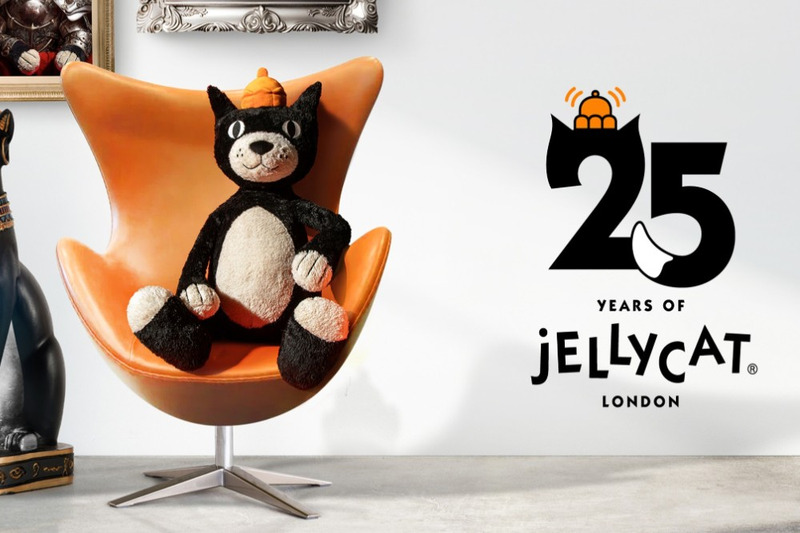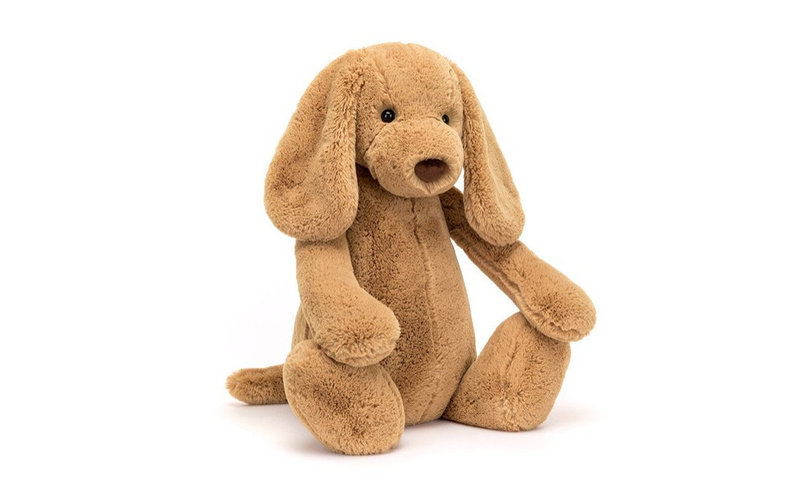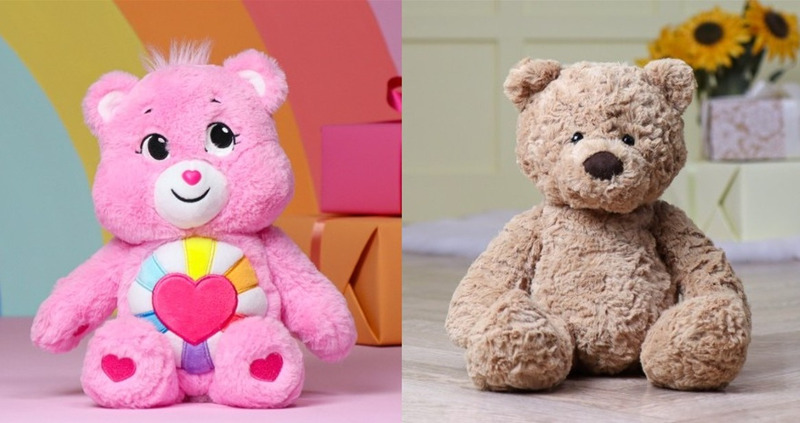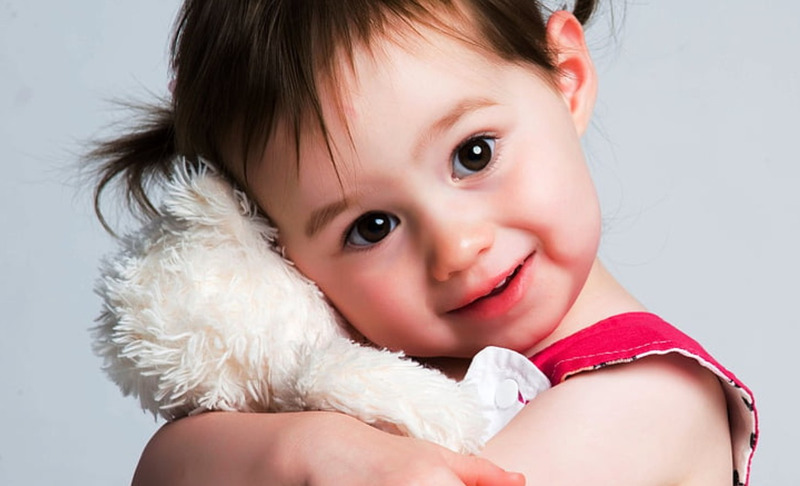
I just found out that Jellycat turned 25 last year. I completely missed the memo. I may be very late to the party, but it struck a chord with me, because my kids have had Jellycat toys since they were tiny.
I was also surprised because I thought the brand was older than that. They feel like they have been around forever don’t they? Jellycat have a heritage feel about them.
Perhaps it’s quite fitting that their birthday passed me by. The brand started as a small independent business and slowly but surely made its way into homes worldwide without anyone noticing. It was a silent takeover but an undeniable one. My fella even bought me one when we first got together – and still liked each other 🤭
Jellycat toys aren’t like other teddys. They are always the child’s favourite. They end up with names, personalities, and probably strong opinions about bedtime. They come with us on holidays, to the supermarket, to first days of school – and I’ve definitely been forced to have conversations with the ones that live in our house. They’re basically part of the family.
So how did they do it? How did Jellycat end up defining childhood for an entire generation?
The Perfect Soft Toy

I can remember my first run in with a Jellycat toy.
I was about 16 and my little cousin was having a 4th birthday party. I was a teenager but I went to the party. Damn right I did. There was cake (and a bouncy castle 🙃).
Anyway, someone had bought him a Jellycat puppy dog, and I was besotted with it. The thing was adorable. All long floppy legs and big soft ears. Something about its expression melted my heart. I probably made that annoying ‘nawww’ noise.
I remember thinking: “this is what teddy bears are like now?” It must have been expensive. It felt expensive. It looked and felt really special. Not like the crappy highly flammable soft toys I got as a 1980s baby. Probably stuffed with a mixture of sand and loft insulation (I was born before health and safety was invented).
Everything else my cousin unwrapped that day was plastic, or had flashing lights, or made a noise, or played a tune. That little puppy didn’t do anything. It was just…nice. Comforting. Premium. And very slightly quirky.
It stood out precisely because it was so simple, but so well made. This is what Jellycat gets right. They make toys that feel luxurious and are well designed, that hark back to a simpler time, and yet feel every bit the modern classic.
Where Did They Come From?
Ready for a bit of niche soft toy history?
Jellycat was founded in London in 1999 by brothers William and Thomas Gatacre. It started as a boutique brand sold in posh baby shops, but it hit a sweet spot with the pricing.
Jellycat toys were just expensive enough to feel a cut above, but not so expensive as to be unaffordable. In other words, most people could afford one as a special gift, but it would still feel like you were buying something high end. Not an impulse buy at the supermarket, but perfect for new babies and special occasions.
When they launched their Bashful Bunny, things really took off. More and more people became aware of the brand and demand increased, then the product range expanded.
This all tied in with the rise of social media too. Let’s be honest, Jellycat toys are infinitely Instagramable. They look cute as hell pretty much anywhere you put them: on top of a pile of washing, next to a sleeping child, on the garden table in the sun. They just make the place feel homely and safe. People talked about them, and social media helped the word spread real fast.
Once the brand were well known they became the go to option for anyone in the market for gifting a soft toy. Anything else felt like a cheap knock off. Because quite frankly, it was.
They Appeal to Parents Too

Do you remember Care Bears? I had one. They were an 80s and 90s thing. That’s what I think of when I think of soft toys from my era: loud, garish, chubby, kind of… sugary, like candy floss.
Can you imagine an adult looking at one and wanting to give it a cuddle? No, me either. Especially now I am an adult. Yuck.
Jellycat toys are the polar opposite. They appeal to everyone. They are understated. Designed to blend in rather than stand out. They have soft, muted colours that are calming and contemporary. They have a tactile design and are made to be held, using super soft velour, ribbed corduroy, or silky soft plush. Their are no beaming smiles and sparkly eyes, and nothing cartoony about them at all. Instead, they have gentle, minimalist expressions that are much deeper. Yes, Jellycat also make croissants, courgettes, and cacti, but the humour is subtle and stylish.
In other words, you can have them littered around your house and they don’t make the place look bad 🤣
They also come with a quiet reassurance of quality. Jellycat toys are well made. They are not going to fall apart. These are toys that survive real life – and a few cycles around the washing machine – and still look better than I do most mornings.
It goes without saying that they are also stupidly cute and cuddly, so they tick every box for parents.
They Become Heirlooms

When my son was born, my other half gave him two toys he had kept from his own childhood: a wooden car, and a stuffed animal.
My son is at school now, and many of his old cuddly toys have been relegated to a box in his room. You know which toys still sit proudly on top of his chest of drawers? The ones his Dad gave him.
It doesn’t matter that they are old and a bit boring in comparison to his other toys. It doesn’t matter that he never actually plays with them. They belonged to his hero, and has absolutely no interest in putting them way.
Jellycat soft toys have the same potential. In fact, they have been around long enough to have been passed down already. A 5 year old who was given a Jellycat toy in 1999 could very well be parent to several children by now. So you can’t tell me there aren’t thousands of rabbits, puppies, and croissants out there already on their second kid.
Jellycat toys are not going out of fashion. They are timeless and built to last. They are the Steiffs, and Merrythoughts of tomorrow. If you don’t know what they are, they are ye olde teddy bear manufacturers – their original products are worth a fortune these days.
These are the sorts of things that become heirlooms. But we don’t keep them because they might be valuable one day. We keep them because they already hold a sentimental value that no price could ever match.
When I look at my little girl’s Jellycat elephant, Trunky, it’s not just some soft toy. I remember the way she used to chew on his ears as a baby, that time she took him to a hospital appointment and made the doctor listen to his heart, the 18 months when she refused to leave the house without him, and the moment she finally felt ready to leave him at home.
She’s going to want to keep that elephant forever. Even if she didn’t, there’s no way I could ever let him go. Trunky will outlast me, of that I’m sure. And I’m pleased about it too.
Because one day, I want to see my grandchild chomping on Trunky’s ears just like my daughter used to. I’ll look back and smile a wrinkly smile, happy in the knowledge that something of my daughter’s childhood lives on, long after that little girl I used to cuddle to sleep grew into a woman. 🥹
So happy belated birthday Jellycat, and here’s to many many more.
